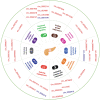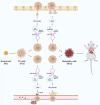Biological functions, mechanisms, and clinical significance of circular RNA in pancreatic cancer: a promising rising star
- PMID: 35729650
- PMCID: PMC9210669
- DOI: 10.1186/s13578-022-00833-3
Biological functions, mechanisms, and clinical significance of circular RNA in pancreatic cancer: a promising rising star
Abstract
Pancreatic cancer (PC) is a highly malignant solid tumor with insidious onset and easy early metastasis. Despite tremendous efforts devoted to research in this field, the mechanisms underlying PC tumorigenesis and progression remain unclear. Additionally, robust biomarkers and satisfactory therapeutic strategies for clinical use in PC patients are still lacking. Circular RNAs (circRNAs) are a new type of non-coding RNA originating from precursor messenger RNAs, with a covalent continuous closed-loop structure, strong stability and high specificity. Accumulating evidence suggests that circRNAs may participate in PC development and progression. Abnormal expression of circRNAs in PC is considered a vital factor that affects tumor cell proliferation, migration, invasion, apoptosis, angiogenesis and drug resistance. In this review of relevant articles published in recent years, we describe the basic knowledge concerning circRNAs, including their classification, biogenesis, functions and research approaches. Moreover, the biological roles and clinical significance of circRNAs related to PC are discussed. Finally, we note the questions remaining from recent studies and anticipate that further investigations will address these gaps in knowledge in this field. In conclusion, we expect to provide insights into circRNAs as potential targets for specific PC diagnosis and treatment in the future.
Keywords: Biomarker; Cancer diagnosis and therapy; CircRNAs; Pancreatic cancer.
© 2022. The Author(s).
Conflict of interest statement
The authors declare that they have no competing interests.
Figures




Similar articles
-
Long Non-Coding RNAs in Pancreatic Cancer: Biologic Functions, Mechanisms, and Clinical Significance.Cancers (Basel). 2022 Apr 24;14(9):2115. doi: 10.3390/cancers14092115. Cancers (Basel). 2022. PMID: 35565245 Free PMC article. Review.
-
Circular RNA in pancreatic cancer: a novel avenue for the roles of diagnosis and treatment.Theranostics. 2021 Jan 1;11(6):2755-2769. doi: 10.7150/thno.56174. eCollection 2021. Theranostics. 2021. PMID: 33456571 Free PMC article. Review.
-
Biogenesis, Functions, and Role of CircRNAs in Lung Cancer.Cancer Manag Res. 2021 Aug 24;13:6651-6671. doi: 10.2147/CMAR.S324812. eCollection 2021. Cancer Manag Res. 2021. PMID: 34466035 Free PMC article. Review.
-
Circular RNAs in prostate cancer: Biogenesis,biological functions, and clinical significance.Mol Ther Nucleic Acids. 2021 Oct 20;26:1130-1147. doi: 10.1016/j.omtn.2021.10.017. eCollection 2021 Dec 3. Mol Ther Nucleic Acids. 2021. PMID: 34820150 Free PMC article. Review.
-
Expression profiles, biological functions and clinical significance of circRNAs in bladder cancer.Mol Cancer. 2021 Jan 4;20(1):4. doi: 10.1186/s12943-020-01300-8. Mol Cancer. 2021. PMID: 33397425 Free PMC article. Review.
Cited by
-
Roles of circular RNAs in the pathogenesis and treatment of pancreatic cancer.Front Cell Dev Biol. 2022 Nov 17;10:1023332. doi: 10.3389/fcell.2022.1023332. eCollection 2022. Front Cell Dev Biol. 2022. PMID: 36467402 Free PMC article. Review.
-
CircATP13A1 (hsa_circ_0000919) promotes cell proliferation and metastasis and inhibits cell apoptosis in pancreatic ductal adenocarcinoma via the miR-186/miR-326/HMGA2 axis: implications for novel therapeutic targets.Am J Cancer Res. 2023 Nov 15;13(11):5610-5625. eCollection 2023. Am J Cancer Res. 2023. PMID: 38058810 Free PMC article.
-
Hsa_circ_0007590/PTBP1 complex reprograms glucose metabolism by reducing the stability of m6A-modified PTEN mRNA in pancreatic ductal adenocarcinoma.Cancer Gene Ther. 2024 Jul;31(7):1090-1102. doi: 10.1038/s41417-024-00786-4. Epub 2024 May 27. Cancer Gene Ther. 2024. PMID: 38802551
-
CircRNA hsa_circ_0004781 promoted cell proliferation by acting as a sponge for miR-9-5p and miR-338-3p and upregulating KLF5 and ADAM17 expression in pancreatic ductal adenocarcinoma.Cancer Cell Int. 2025 Feb 19;25(1):56. doi: 10.1186/s12935-025-03687-0. Cancer Cell Int. 2025. PMID: 39972489 Free PMC article.
-
Hypoxia-induced exosomal circPDK1 promotes pancreatic cancer glycolysis via c-myc activation by modulating miR-628-3p/BPTF axis and degrading BIN1.J Hematol Oncol. 2022 Sep 6;15(1):128. doi: 10.1186/s13045-022-01348-7. J Hematol Oncol. 2022. PMID: 36068586 Free PMC article.
References
Publication types
Grants and funding
LinkOut - more resources
Full Text Sources

